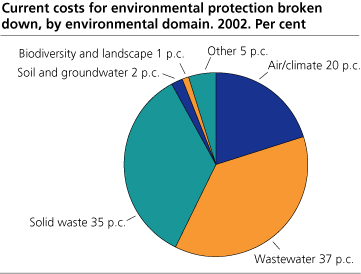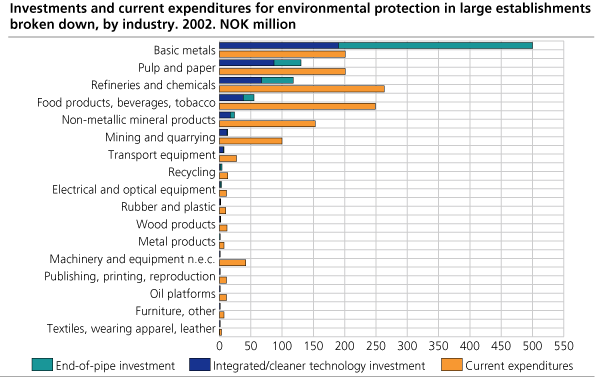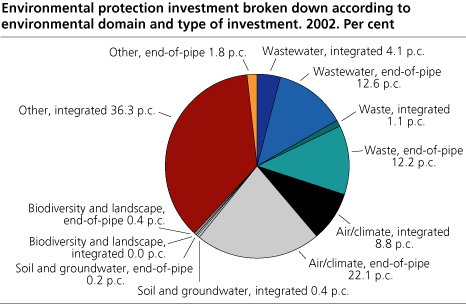Content
Published:
This is an archived release.
Large manufacturing establishments spent over NOK 2.2 billion on environmental protection
For the first time Norwegian establishments have reported current costs related to environmental protection, and in 2002 such costs came to a total of NOK 1.3 billion for large establishments in the manufacturing, mining and quarrying industries. In the same year, these establishments invested approximately NOK 860 million in environmental protection measures, making the total costs for environmental protection over NOK 2.2 billion.
This represents 1 per cent of the costs of goods and services consumed, compensation of employees and gross investment in these establishments. The investments focused mostly on reducing air emissions while current costs were highest for wastewater and waste.
These statistics are based on information from a sample survey of 1 173 of the largest establishments classified in the manufacturing and mining and quarrying industries, where the industries with the largest expected environmental protection investments were best represented in the sample. It has been estimated that the environmental protection investments for these establishments accounted for over 70 per cent of the total environmental protection investment in the manufacturing and mining and quarrying industries. Gross investment in this sample accounted for approximately 60 per cent of total gross investment in the manufacturing, mining and quarrying industries while the current expenditures in the sample accounted for just under 55 per cent of the total.
Current expenditures mostly for wastewater and waste
NOK 950 million or about 72 per cent of current costs for environmental protection were related to wastewater and waste. These costs included municipal fees and other wastewater and solid waste fees. At the same time, costs for reducing air emissions were NOK 265 million or approximately 20 per cent of environmental protection current costs. Costs for CO2 taxes and other environmental taxes are not included.
Four industries, in particular, stand out because of their high current expenditures for environmental protection. In addition to the pulp and paper industry, oil refineries and chemical industry, and basic metals industry, the food products, beverages and tobacco industry had the highest current costs, at approximately NOK 249 million. The food products, beverages and tobacco industry consists of a large number of production units and most of them reported current costs connected to environmental protection. These costs are particularly focused in the environmental domains of waste and wastewater.
Industries that have high current costs for environmental protection do not necessarily have high investment levels for the same environmental domain. One explanation can be that costs for wastewater and waste treatment account for a large portion of the reported current costs and these expenditures are not necessarily directly linked to the establishments own investments. This pattern is particularly observed for mining and quarrying, non-metallic mineral products, and the food products, beverages and tobacco industries.
Most investments for air and waste measures
So-called end-of-pipe or pollution treatment investments are an important part of environmental protection investments and Norwegian establishments reported NOK 426 million in costs related to this type of investment in 2002. Investments in measures focusing on air emissions continue to be important. These investments accounted for 45 per cent of all end-of-pipe investment while end-of-pipe investments in solid waste measures accounted for about 25 per cent.
A large proportion of integrated technology investment (72 per cent) is not specified according to environmental domain. One reason for this can be that it is often difficult for establishments to divide up a large investment according to environmental domains if more than one domain is covered by the investment. Of the integrated technology investments that have been reported according to environmental domain, just about 61 per cent of the investment went to measures focused on air/climate emissions and 28 per cent of the investment went to treatment of wastewater/production water.
The pulp and paper industry reported NOK 43 million in integrated technology investments. And with respect to end-of-pipe investments, the pulp and paper industry also had a relatively high investment level with over NOK 87 million or 20 per cent of total reported end-of-pipe investment. All together this industry invested more than NOK 22 800 per employed person, in environmental protection measures.
The basic metals industry had the highest share of end-of-pipe investments, and used NOK 190 million. In addition, high levels were reported for integrated technology investments, which means that this industry used almost 10 per cent of its total gross investment for environmental protection purposes. This industry alone accounted for over half of total environmental protection investment in the manufacturing, mining and quarrying industries.
The basic metals industry also had a larger share of integrated technology investments than the other industries. The pulp and paper industry and the oil refineries and chemical industry also have high levels of integrated technology investments. Most industries still invest more in pollution treatment or so-called end-of-pipe solutions than in cleaner, integrated production technology.
More about environmental protection investments
Environmental protection investment was reported for the accounting year 2002 according to two main categories, integrated technology and end-of-pipe technology, while only end-of-pipe investments were reported in 2001. The purpose of end-of-pipe or pollution treatment investments is to treat, control or measure pollution, whereas integrated technology investments are connected to cleaner technology within production processes and are also considered pollution prevention measures.
In connection with the reporting of integrated technology investments, the establishments have given a short description of the investment. Examples of investments that were made in 2002 include measures for waste reduction including improved production equipment that use raw materials more efficiently and thus result in less waste, and equipment for reusing cooling water. These types of investments typically result in increases in production efficiency as well as providing a positive environmental effect. It is likely that there is a certain amount of errors in the reporting of this type of investment since the portion of the investment that is specifically connected to environmental protection can be difficult to estimate. Establishments in the survey reported that they used NOK 438 million for integrated technology investments in 2002. A large portion of the integrated technology investments in 2002 was connected to large individual investments in the basic metals industry.
Tables:
Contact
-
Martin Lundeby Grimstad
E-mail: martin.grimstad@ssb.no
tel.: (+47) 90 66 47 43
-
Trine Heill Braathu Randen
E-mail: trine.heill.braathu.randen@ssb.no
tel.: (+47) 91 10 67 45



